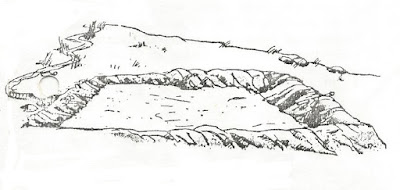BUILDING A POND
Choosing the site
You will need a good source of water such as springs, streams and ground water.
You can also rely on rain water. Rain filled pond often dry up in dry season, so you must harvest the fish before the water level falls too low.
Soil containing clay is the best for building
fish ponds because it holds water well.
To examine the soil, dig a hole 1m deep and
take sample of soil from the bottom.
Moisten this soil and squeeze a handful of it
into a ball, throw it about 50cm into the air and then catch it.
If the ball falls apart in your hand this
means it is not good for building ponds. Look for another site or use a lining for
the ponds.
If the ball holds together it probably has
enough clay for fish pond.
Pond Design
Fish ponds should be build so they can be filed easily
and drain completely. Rectangular ponds are easier to build and harvest than
round or square ponds.
The smallest pond we recommend is 10m x 15m (150 square
metres) ponds can be much larger, but for family use it is better to have
several small ponds than one.
7 STEPS TO BUILDING YOUR EARTHEN POND
Prepare the site
Remove trees, vegetation and rocks.
Measure
and stake out the pond.
Remove the top layer of the soil and keep it outside
the pond area.
Building a clay core
(If you are building a contour pond)
A clay core is like a foundation for the
pond bank which makes it strong and prevent leaks.
Dig a trench 50cm wide and
30-60cm deep (or until you reach the clay subsoil). This trench should be just
outside the lower side of the pond and halfway up reach side of the pond.
Fill
in the trench with good clay soil, well compacted down.
This will now provide a
strong foundation for the ponds walls.
Dig the pond and build the walls
As you dig down, use the soil to build up
the walls.
Compact the soil as you build the walls by trapping it with our feet
or pounding it with a heavy log.
If you find poor sandy soil, throw this
outside the pond area – don’t use it for building the walls.
The ponds walls should be about 30cm above
the water leveling the pond.
They should have a gentle sign, rising 1m in
height for every 2m in length.
Build the inlet and outlet
The inlet pipe carries water for filling
the pond. This often contains a lot of soil which could make the pond very
muddy.
When digging the channel to bring in the
water, dig a hole beneath the inlet pipe.
This will allow soil to settle and prevent
the pond from filling up with dirt.
The inlet pipe runs throw the pond wall
into the pond.
It should be screened to prevent wild fish
from entering.
It should be about 15cm above water level.
This prevents fish from escaping through it and mixes air into the water as its
splashes into the pond.
The water should be 30cm deep at one end
and 1m deep at the other.
You can dig it deeper, but make sure all the water
can be drained out for harvesting the fish.
Contour ponds are built in areas with sloping land.
The
soil on the upper side of the pond is dug out and used to build up a dam on the
lower side.
The dam must be strong because the water level in the
pond will be above the original ground level.
Dug out ponds are built in flat areas by digging out the
soil. Water level is below the original ground level.
See various views of Dug out ponds below:
Protect the Pond Banks
When you finish building the pond bank,
cover them with plants that you saved to prevent the banks from erosion.
During heavy rains, dig a run off ditch
along the upper side of the pond to carry water away from the pond, preventing
damage to the walls.
The outlet is an overflow pipe through the
pond wall which is only used in emergencies.
Water should not normally flow out of the
pond. The outlet should always be screened to stop fish from leaving the pond. See
drawing below:
·
Wire
mesh
·
A clay
pot with holes
·
Pieces
of metal with holes
·
Mosquito
netting
Build Compost fences and add fertilizer
Build the compost fences when the pond is
dry, using sticks that will not rot.
Fill the baskets and spread a layer of manure
on the bottom of the pond, before filling with water.
Filling the pond
Place rocks on the bottom where the water
will splash in from the inlet pipe.
This will keep the water from digging a
hole and eroding the pond bottom. Do not over fill the pond so that water flows
out.
Fill the pond at least two weeks before you
stock the fish.
This allows the pond to become warm and
fertile before fish are stocked.
The pond may seep water at first, but
should seal eventually as mud and fertilizer build up on the bottom.
Adapted from Raising Fish in
Ponds by Dennis and Meredith
Sketches by Barbara Knutson.






















No comments:
Post a Comment